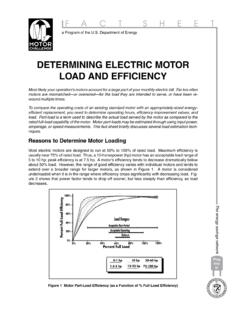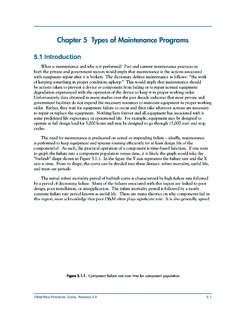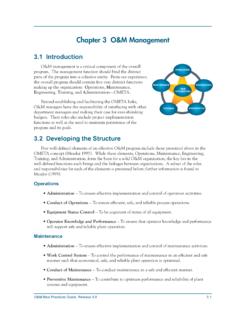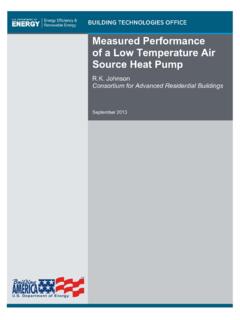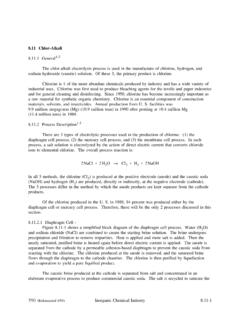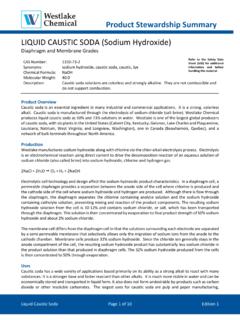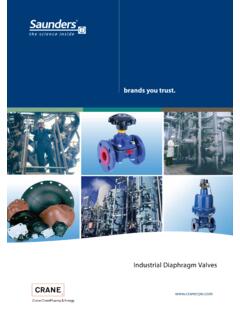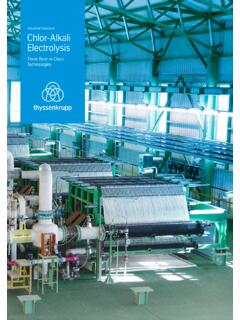Transcription of The Chlor-Alkali Industry - Energy
1 Production of Major Products in the Caustics Chain (1997)Chlorine ( billion lbs)Sodium Carbonate ( billion lbs)Sodium Hydroxide ( billion lbs)Source: CMA 1998. The Overview of the Chlor-AlkaliIndustry Chlorine, Sodium Hydroxide, and SodiumCarbonate Are Primary Products of theChlor- alkali IndustryThe caustics chain begins with sodium chloride(NaCl) and forms the basis for what is oftenreferred to as the Chlor-Alkali Industry . Majorproducts of the Chlor-Alkali Industry includechlorine, sodium hydroxide (caustic soda),soda ash (sodium carbonate), sodiumbicarbonate, potassium hydroxide, andpotassium carbonate. Of these products,chlorine, sodium hydroxide, and soda ash accountfor the largest share of shipments from the Chlor-Alkali Industry . These products are also veryimportant economically, being the chemicalsproduced in the eighth, ninth, and tenth largestamounts in the United States (in 1997, theircombined production was over 72 billion pounds)(CMA 1998).
2 Most of the chlorine produced in the UnitedStates (about 70 percent) is used to manufactureorganic chemicals ( , vinyl chloride monomer,ethylene dichloride, glycerine, chlorinatedsolvents, glycols). Nearly 40 percent is used forthe production of vinyl chloride, an importantbuilding block for poly vinyl chloride (PVC) and anumber of petrochemicals (see Figure 6-1). Chlorine is also important to the pulp and paperindustry, which consumes about 15 percent of thechlorine produced annually. Other major uses forchlorine include the manufacture of inorganicchemicals, disinfection of water, and productionof hypochlorite (CMA 1998, Orica 1999). 176 Salt WaterChlorineCaustic Soda(SodiumHydroxide)Ethylene dichloride/vinyl chloridemonomer, polyurethanes, otherorganic compounds, pulp and paper,solvents, water treatment, titaniumdioxideChemical manufacturing, pulp andpaper, soaps and detergents,textiles, alumina, petroleum refiningSalt andLimestone(synthetic) orTrona Ore(natural)Soda Ash(SodiumCarbonate)Glass-making, detergents andsoaps, neutralization, metals andmining, sulfite paper pulping,chemical sodium compounds,textiles processingThe Caustics Chain Figure 6-1.
3 Chlor-Alkali Products Chain (CMA 1998)About 30 percent of the sodium hydroxideproduced is used by the organic chemical industryand about 20 percent is consumed by theinorganic chemical Industry for neutralization andoff-gas scrubbing, and as an input into theproduction of various chemical products ( ,alumina, propylene oxide, polycarbonate resin,expoxies, synthetic fibers, soaps, detergents,rayon, cellophane). Another 20 percent ofsodium hydroxide production is used by the pulpand paper Industry for pulping wood chips and forother processes. Sodium hydroxide is also usedto manufacture soap and cleaning products, andas drilling fluid for oil and gas extraction(CHEMX 1999, Orica 1999).Soda ash is used primarily by the glass industryas a flux to reduce the melting point of sand.
4 It isalso a raw material in the manufacture of sodiumphosphates and sodium silicates, importantcomponents of domestic and industrial cleaners. Other uses are in the production of metals inboth the refining and smelting stages, in sulfitepaper pulping processes, and in textilesprocessing. Soda ash is also an intermediate inthe production of sodium compounds, includingphosphates, silicates, and for Sodium Hydroxide andChlorine Is Impacted by GlobalEconomiesThe Chlor-Alkali Industry has been growing at aslow pace over the last 10 years and this rate isexpected to continue in the early years of thenew century. Chlorine and sodium hydroxide areco-products, and the demand for one will highlyinfluence the demand for the other. Over the lastseveral decades, market forces have switchedbetween chlorine and sodium hydroxide a numberof times.
5 Chlorine demand drives the chlor-alkaliindustry, but the demand is cyclical, with chlorineand caustic soda out of phase in the caustic soda reaches a high level ofdemand, the direction of product flow isdependent upon Asian and European economiesand the foreign exchange rate. Foreignproducers may often export caustic soda to the177 United States to keep chlorine production high,which impacts both markets and production in thiscountry (DOW 1999).Prices for both chlorine and caustic soda areimpacted by changes in vinyl exports to Asia andweakness in the pulp and paper Industry . Important Asian economies ( , Japan) willcontinue to drive demand for both these productsand set the pace of new production facilities inthe United States. The fact that the UnitedStates remains competitive in the chlorine-caustic-vinyl cycle can be attributed to threefactors: our large supplies of Energy and rawmaterials (salt and ethylene), and our large-scaleeconomy.
6 With the exception of Taiwan, worldscale vinyl plants are not being built in Asia(DOW 1999).Other forces affecting the market for chlor-alkalis include environmental regulations aimed atcurtailing chlorine use. For example, restrictionson the production or disposal of products thatrequire large amounts of chlorine ( , PVC,chlorinated solvents) have had a negative impacton the chlorine market. Several environmentalgroups and initiatives ( , International JointCommission of Great Lakes Water Quality) arecalling for a gradual phaseout or immediate banon chlorine and chlorinated compounds asindustrial feedstocks, which is also impactingcommercial use of chlorine (CCC 1995, EPA1995a, CCC 1996, Ayres 1997).However, demand for PVC has been asignificant driver in the growth of chlorine useboth in the United States and globally.
7 Theindustrialization of Asia is expected to drive PVCdemand and chlorine growth well into the nextcentury. Until a non-chlorine replacement forPVC is developed, demand will remain strong(DOW 1999).Demand for sodium hydroxide may also beimpacted by users switching to soda ash to avoidshortages of sodium hydroxide (like theworldwide shortage that occurred in the late1980s). Soda ash is very plentiful in the UnitedStates and is obtained almost entirely from naturalsources of trona ore . However, it is moreexpensive to mine soda ash than to produce 50percent caustic, so increased use of soda ash isnot likely to occur unless the price of caustic isrelatively high (Chenier 1992, DOW 1999). Demand for sodium hydroxide may also beimpacted as pulp and paper mills increasingly lookfor cost-effective ways to recycle sodiumhydroxide from spent pulping liquor.
8 Currently,however, most of these alternatives cannotcompete on a capital and cost basis with causticsoda production, and will only impact demandwhen they become economically viable (EPA1995a, CHEMWK 1999).Chlorine is difficult to store and transporteconomically. As a result, chlorine and causticsoda are usually produced in close proximity toend-users (primarily chemical manufacturers andpulp and paper mills). Geographically, about 72percent of chlorine production takes place inchlor- alkali facilities located along the Gulf Coast;other production occurs in the vicinity of pulpmills of the Southeast and Manufacture of Chlorine andSodium HydroxideChlorine and Sodium Hydroxide Are Co-Products of Brine ElectrolysisChlorine was first discovered in 1774 by theGerman chemist Scheele, and was identified asan element in 1810 by an English scientist namedDavy.
9 Caustic soda, or sodium hydroxide, hasbeen an important industrial chemical since1853. Until 1892 sodium hydroxide was produced by thereaction of slaked lime and soda ash. That year,the electrolysis of brine was discovered as amethod of making both sodium hydroxide andchlorine. Since the 1960s electrolysis has beenthe predominant technique employed tomanufacture these two important chemicals(Chenier 1992, Orica 1999). Although electrolysis of brine is the primaryproduction method, technologies for converting aqueous hydrochloric acid to chlorine are alsoused in the United States and Europe. A process178 to convert anhydrous hydrochloric acid tochlorine, developed jointly by Dupont andKvarner Chemetics, was also recently unveiled. Similar technology is also being marketed inEurope by DeNora, an Italian and sodium hydroxide are co-productsthat are produced in roughly equivalent amountsthrough electrolysis of common salt in a brinesolution (about tons of sodium hydroxide forevery ton of chlorine produced).
10 Hydrogen isalso produced in equal molar amounts withchlorine and caustic. Chemical demand forhydrogen on the Gulf Coast is significant, and it isoften transported by pipeline long distances tomeet the needs of oil refineries. There is also anopportunity to use fuel cell technology to closelycouple the hydrogen produced with electricalpower units that can feed DC power to chlorinecells. Some demonstration units using thistechnology are in operation outside the UnitedStates (DOW 1999). During electrolysis, two electrodes are immersedin a brine solution. When a source of directcurrent is attached to the electrodes, sodium ionsbegin to move toward the negative electrode(cathode) and chlorine ions toward the positiveelectrode (anode) (Sittig 1977, IND CHEM 1990,EPA 1995a, Orica 1999).


